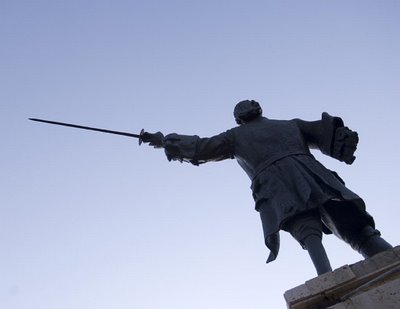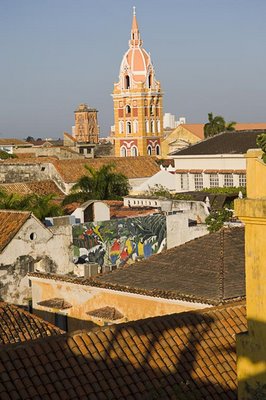
Before arriving in Cartagena (that would be my pre-Colombian period), I knew very little about it. Now that I’ve been there and had a taste of its charming architecture, amazing seafood and wild history, all I can think of is how soon can I get back for more.
Cartagena is a deep water port strategically located on the Caribbean Sea close to Panama. For that reason its history is long and colorful and prominently features names like Sir Frances Drake and Simon Bolivar.
You could call it the Plymouth Rock of South America because it is where Columbus first landed on the continent (Colombia – duh). Later the imperialist bloody Conquistadors arrived and set up shop, killing and pillaging to rave reviews from their homies back in Spain. The Spanish flotilla transported tons of gold, silver and other precious goods from Cartagena to Spain and in return sent the Spanish Inquisition to Cartagena. Talk about a trade imbalance…

The slave business boomed in Cartagena from the 1500s to 1800s. Slave-traders knew the town had the biggest and most cost effective market of human-wares. Merchandise included the nearby easy-picking, homegrown native Indian populations of South America as well as exotic African imports. In Cartagena you could find something for everyone’s taste and pocketbook in slaves. It was sorta a Walmart of human goods. They probably had signs saying the equivalent of: Male Africans on aisle 2; Female Indians on aisle 8, Blue Light Special on Pigmys, aisle 6, etc.

A Pirate’s Life for me
But most interesting of all of Cartagena’s rich history is its reputation as a main port-o-call for swash-buckling, romantic Pirates of the Caribbean (visions of Johnny Depp are dancing through my head). The original old town is still totally surrounded by a 2-foot thick fortified wall built to guard against the darling – I mean daring - opportunistic buccaneers. The wall must have done it’s job because inside the barricade the entire town with its winding cobblestone streets lined with colorfully painted Spanish Colonial architecture remains almost exactly as it was back 500 years ago. Except for the prices, of course.

Gold and silver plundered from the Incas was transported back to Spain from Cartagena in annual convoys of the Spanish Armada. It must have been some sight to see dozens of tall ships anchored there with their sails billowing and the sea sparkling and the pirates grinning... Because of course other European nations knew Cartagena was booty-central. Pirates and buccaneers from France and England regularly attacked on both land and sea. Sir Frances Drake was one of the most ruthless and successful pirates, raiding and capturing tons of Spanish plunder. For some reason his reputation has been sanitized and elevated to “adventurer” by most historians, but pirate he was – looting in the name of QE1 (Queen Liz the First).
Legend has it that when Blackbeard the murderous pirate was spotted alone in a bar in Cartagena, a brave stranger approached and asked him where were his buccaneers? He growled back, “Arrgggg – they be under me buckin’ hat of course, how else could I hear ye?”